
10 Best Glute Exercises
Build strong, functional glutes with this workout: 10 of the most effective glute exercises you can do at home with minimal equipment. Moves like hip thrusts, Romanian deadlifts and step-ups sculpt the gluteus maximus, medius and minimus, helping you grow your glutes, improve hip/knee stability and reduce lower back pain. This exercise routine is perfect for busy women, postpartum moms and anyone who wants to build their glute muscles at home – no barbell needed.
It’s no secret that I love leg day: big lifts like squats, deadlifts, hip thrusts and lunges make me feel strong, powerful and accomplished. But there’s one lower-body movement in particular that always makes me sore – glute exercises!
The 10 glute exercises included in today’s workout target all 3 parts of the glute muscles: the gluteus maximus, gluteus medius and gluteus minimus.
It’s incredibly common to lose muscle mass in the glutes during pregnancy and postpartum recovery (which is where the term “mom butt” comes from – which is offensive, but tells you how common this issue is!). During pregnancy, an anterior pelvic tilt (forward-tilting pelvis) can weaken the gluteal muscles, leading to lower back pain, hip instability and ultimately a flatter appearance.
Although my DMs are filled with messages asking “how do I fix my flat butt?” training your glutes is important for so much beyond aesthetics. Strong glutes help you to run faster, jump more explosively, reduce hip and knee pain and support better posture and stabilization through the lower body. Additionally, your glute muscles make daily tasks like walking up stairs and chasing after kids easier and less painful.
These are 10 of the most effective glute isolation exercises that build muscle mass in the posterior chain, leading to big, strong glutes. We’ll start with the classic best glute exercises for beginners (such as glute bridges and clamshells) and then increase the intensity with more advanced exercises (like Bulgarian split squats and curtsy lunges). This is an approachable at-home butt workout for beginners and advanced athletes alike.
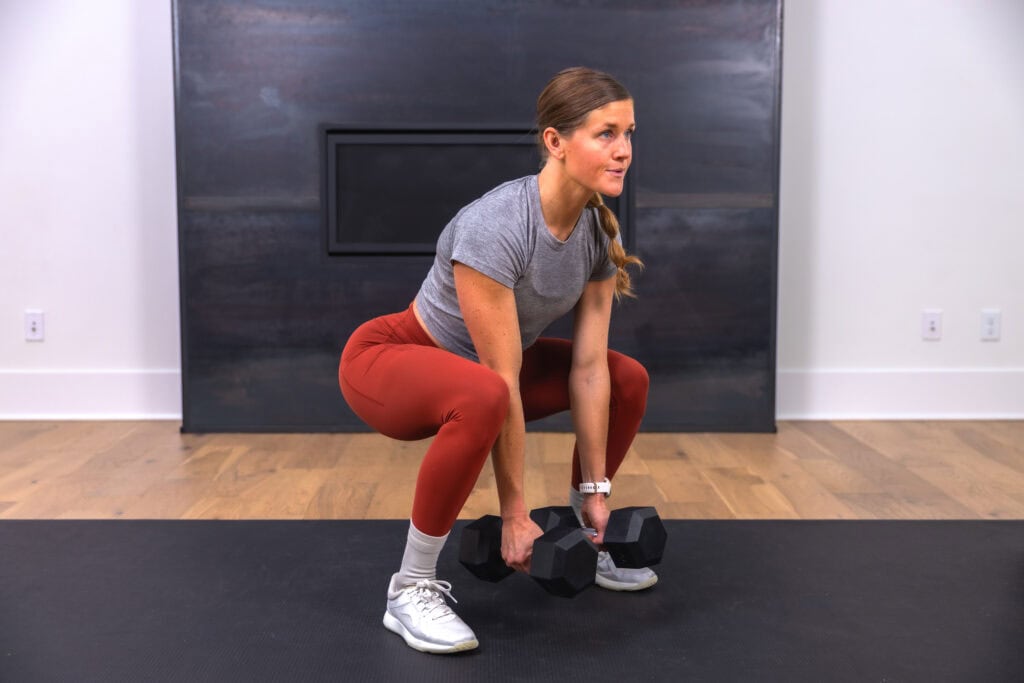
Workout Equipment:
A medium-to-heavy set of dumbbells. I suggest anywhere from 5-25 lbs. You could also substitute a kettlebell if that’s what you have available.
Want an extra challenge? Add a mini loop resistance band to increase outer glute engagement.
Workout Instructions:
Note that this is a list of my favorite glute exercises. If you prefer a guided home workout video (complete with a warm-up and cool-down), try this 40-Minute Glute Workout.
Trainer Tip: If you struggle to feel your glutes “turn on” or fire up during leg exercises, start with this guided Glute Activation routine!
How To Use This Dumbbell Glute Workout:
- Beginner: 30 seconds work, 15 seconds rest. Perform each exercise x1 set.
- Intermediate: 40 seconds work, 20 seconds rest. Perform each exercise x2 sets.
- Advanced: 45 seconds work, 15 seconds rest. Perform each exercise x3 sets.
Workout Outline
1. Glute-Biased Squat
Targets: Glutes, quads and hamstrings.

How to Do a Glute-Biased Squat
- Stand with your feet shoulder-width apart. Hold a set of dumbbells between your legs, hanging slightly in front of you.
- With a slight bend in your knees, hinge forward at the hips until your torso is parallel to the ground. Core is engaged, and spine is neutral (back flat). You should feel a stretch in your hamstrings (back of the legs).
- Maintain this forward hinge as you lower down into a squat, pushing your hips down until your hips align with your knees (making a 90-degree angle with your hips and knees). Knees push out towards your outer three toes. If possible, tap the dumbbells to the ground.
- Drive through your heels to stand as you continue to maintain the forward hinge. To make this exercise harder, keep constant tension on the glutes by never standing straight up, keeping a slight bend in the knees.
2. Step-Up
Targets: Quads and all 3 parts of the glutes — the gluteus maximus, gluteus medius and gluteus minimus.
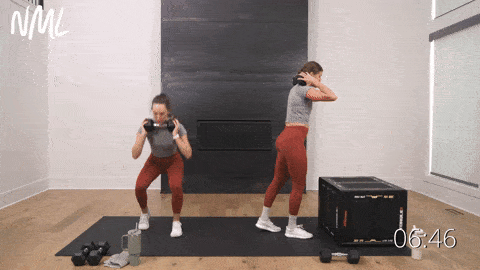
How to Do a Step-Up
- Start standing, feet shoulder-width apart, core tight and engaged. Option to hold a dumbbell vertically at your chest (goblet hold) or racked horizontally on your back.
- Step your right foot up onto a bench or chair, planting your right heel firmly on the surface.
- Drive through your right heel, using your right glute (rather than momentum from your left leg), to stand tall.
- With control, slowly lower your left foot down to touch the ground, returning to the starting position. In this variation, we’re increasing the time under tension by lowering down to the ground on a 3-count.
Modification: The lower the step, the less intense this exercise is. The bottom step of a staircase is a great place to start. If you don’t have a step available, perform a reverse lunge with a knee drive or a staggered squat with a knee drive.
3. Bulgarian Split Squat
Targets: Legs, glutes, quads, hamstrings, hips and core.
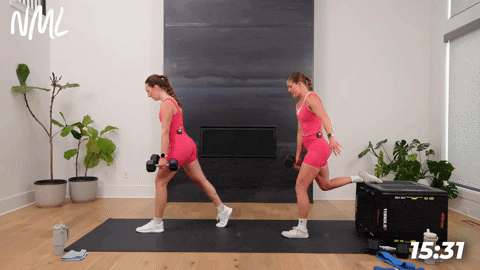
How to Do a Bulgarian Split Squat
- Kneel in front of your bench or chair, then place your left foot behind you on the chair or bench, shoelaces down. Hold a dumbbell in your left hand.
- Step your right foot forward (it will vary for everyone, but a little over a foot in front of your bench). Your front thigh will be parallel to the floor. This is the bottom of your movement.
- Drive through your front right heel, squeezing your right glute to return to standing. Feel your front glute engage to power the movement.
- With control, bend your knee to lower back down to the starting position (back left knee should lower down close to the ground), to make your front thigh parallel with the ground. Shoulders remain stacked over hips throughout the movement.
Modification: Perform a standard reverse lunge or split squat, keeping your back foot on the ground rather than elevating it on a chair.
4. Romanian Deadlift
Targets: All the posterior chain muscles, including the hamstrings, glutes, core, lats and lower back.

How to Do a Romanian Deadlift (RDL)
- Stand with your feet hip-width apart, holding a dumbbell in each hand in front of your hips (palms facing in towards your body).
- Hinge at the hips, pushing your hips back towards the wall behind you as you glide the dumbbells down the front of your legs, keeping your core tight, slightly bending both knees. Lower your dumbbells until you feel a stretch in the hamstrings, hinging your upper body towards the ground. The range of motion will look different for everyone.
- Drive through your heels to push your hips forward, pulling the dumbbells back up towards your hips and returning to the starting position. Aim for full hip extension at the top of the movement.
5. Good Mornings
Targets: Hamstrings, gluteus maximus, erector spinae and lower back muscles.

How to Do a Good Morning
- Start in a standing position, feet shoulder-width apart, core engaged, hands placed behind your head. Option to add weight by resting 1 dumbbell horizontally on your upper back. Hold each head of the dumbbell with 1 hand.
- With a slight bend in your knees, hinge forward at the hips until your torso is parallel to the ground. Core engaged and spine neutral (back flat).
- You should feel a stretch in your hamstrings (back of the legs) at the bottom of the movement.
- Reverse the movement, driving through your heels to stand tall, returning to the starting position (torso upright).
6. Curtsy Lunge
Targets: Legs, quads (thighs), gluteus maximus, gluteus minimus, hip flexors and core.
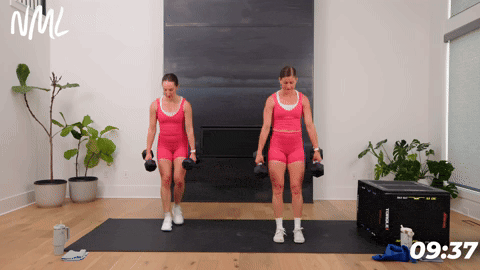
How to Do a Curtsy Lunge
- Stand with your feet hip-distance apart, holding a pair of dumbbells at your sides.
- Step your left leg back into a curtsy lunge (left back knee should meet right calf as your left knee lowers towards the mat). Lower your hips until both knees reach a 90-degree angle, front thigh parallel to the floor.
- Squeeze your right glute to reverse the movement, stepping your left foot back to center and standing tall.
- Repeat, this time stepping your right leg back into a curtsy lunge (right knee should meet left calf as your right knee lowers towards the mat). Lower your hips until both knees reach a 90-degree angle, front thigh parallel to the floor.
- Squeeze your left glute to reverse the movement, stepping your right foot back to center and standing tall.
Modification: If lunges aren’t comfortable for your knees, try one of these lunge modifications.
7. Glute Bridge
Targets: Glutes, hamstrings and hip abductor muscles.

How to Do a Glute Bridge
- Lie on your back with your knees bent at 90 degrees and your feet flat on the ground. Hold a dumbbell across your hips, resting the dumbbell on your hip bones.
- Press through your heels to raise your hips off the ground until your knees, hips and shoulders form a straight line. Squeeze your glutes hard and keep your abs drawn in so you don’t overextend your back during the exercise.
- Lower your hips back down to a hovering position and repeat.
8. Single Leg Hip Thrust
Targets: Glutes (both the gluteus maximus and gluteus medius), hamstrings, hip adductors, core and pelvic floor.
Want an extra challenge? Try the 8-8-8 method for glutes during this move: for each set of hip thrusts, perform (8) full range repetitions, followed by (8) top-half reps and finish with (8) bottom-half reps.
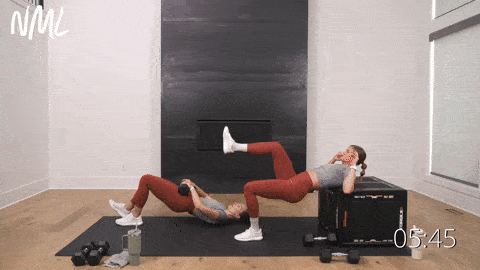
How to Do a Single Leg Hip Thrust
- Sit in front of a bench or chair, feet flat on the floor and hip distance apart. Lean back, resting your upper back on the bench. Option to hold one dumbbell at your hips, resting on your hip bones.
- Press your weight into your right heel and lift the left foot off the mat.
- Then press through the right heel to lift your hips until your right knee, hips and shoulders form a straight line. Squeeze your glutes and pull the belly button in towards the spine to protect the low back and prevent overextension.
- Hold at the top of the hip thrust for a moment before lowering your hips back to the starting position with control.
Modification: Perform staggered glute bridges or single-leg glute bridges from the floor.
9. Clamshells
Targets: Gluteus medius (which lays on the outer edge of the buttocks and is responsible for stabilizing your pelvis and hip abduction), gluteus minimus, obliques and core.
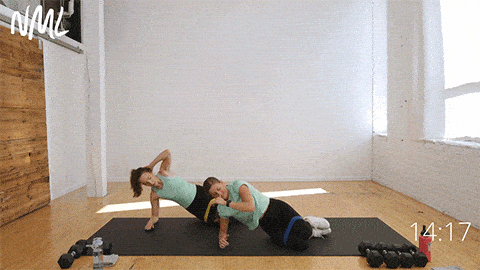
How to Do a Clamshell
- Lie on your left side, with legs stacked and knees bent at a 45-degree angle, soles of the feet to touch. Your left forearm is stacked under your left shoulder.
- Exhale to engage the core and stabilize your spine and pelvic floor.
- Keeping your feet touching, use your outer glutes to lift your hips off the floor. As you lift your hips off the ground, open your legs, raising your upper right knee as high as you can without shifting your hips or pelvis (mimicking a clamshell opening).
- Pause and hold at the top of the movement for a moment. Then return to the starting position.
10. Donkey Kicks
Targets: The gluteus maximus (the largest of your three glutes muscles) core and shoulder muscles.

How to Do a Donkey Kick
- Start in a tabletop position with your knees bent at 90-degree angles and your hips stacked over your knees. Place your left forearm and right hand flat on the mat, shoulders stacked over elbows.
- Maintain the 90-degree bend in your right knee as you lift your right leg off the ground, pressing your right heel towards the ceiling. Left knee remains planted on the ground. Focus on moving your leg by squeezing your glutes rather than arching through the back.
- With control, slowly lower your right knee, returning to the starting position.
FAQs
On average, it takes 8-12 weeks of target strength training to see results from glute exercises when paired with a high-protein diet. Factors such as body composition, genetics and training intensity will all influence how quickly each individual sees results.
I recommend training glutes 1-2x per week as part of a well-rounded progressive overload workout plan. This provides enough volume to build strength and trigger muscle growth without overtraining the muscles, which can lead to injury.
Hip/knee pain, lower back pain, poor posture, and difficulty with exercises like squats or walking up stairs can all be warning signs of weak glutes. When your glutes are weak, your other muscles and joints take on more pressure and labor, which can cause instability and pain.
More Workouts
Lower-BodyPin This: Build Your Leg Day With These 12 Exercises
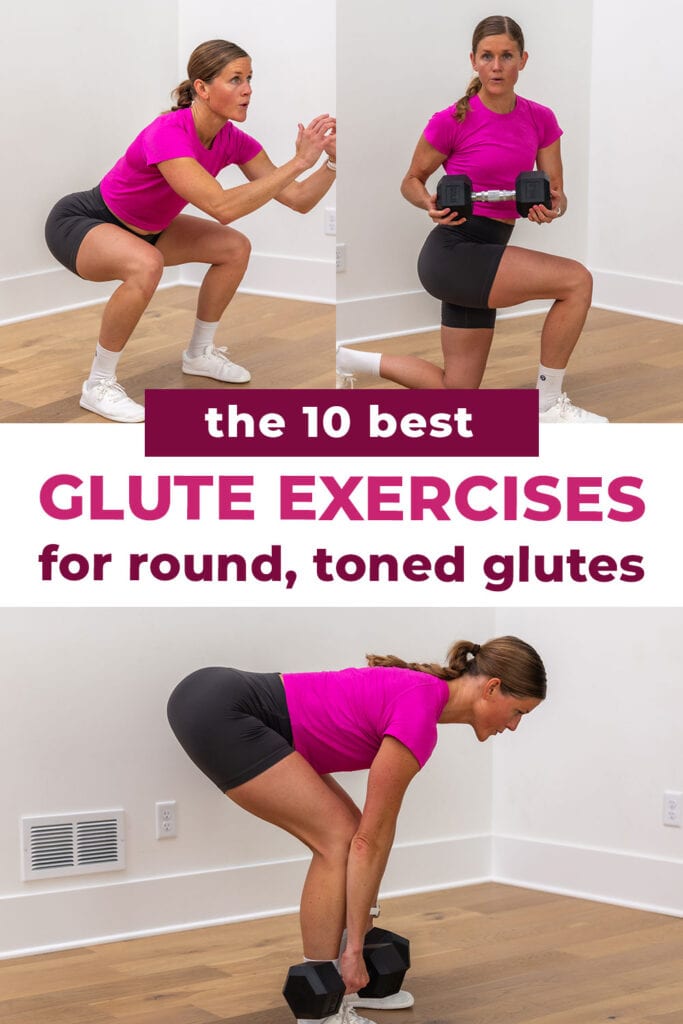











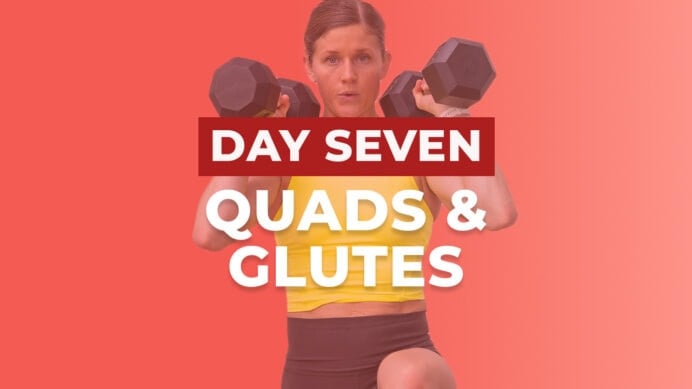
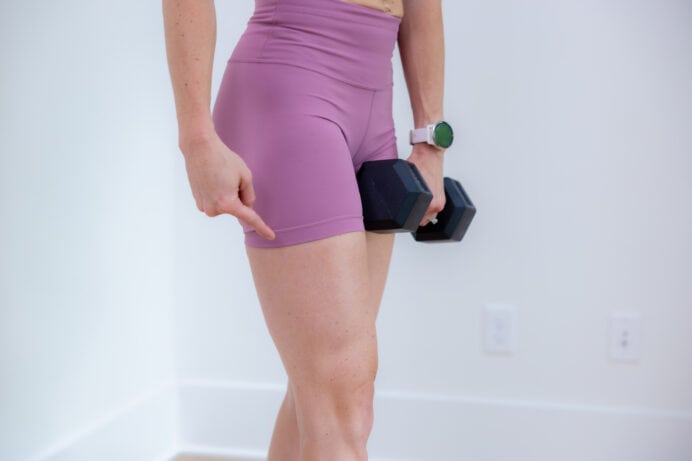
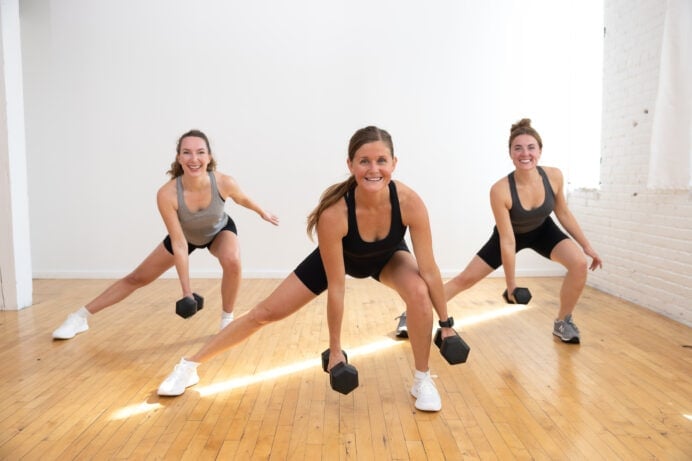
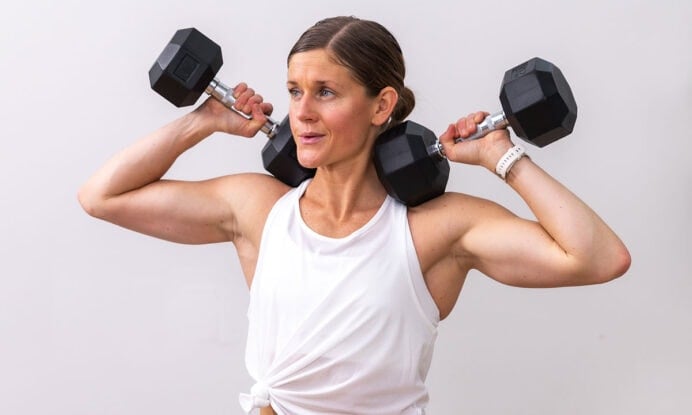
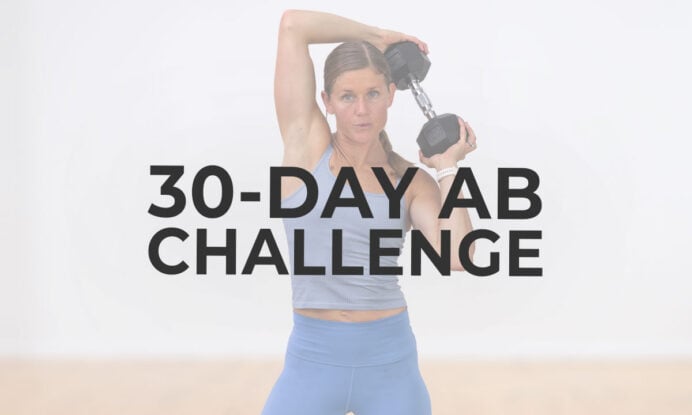
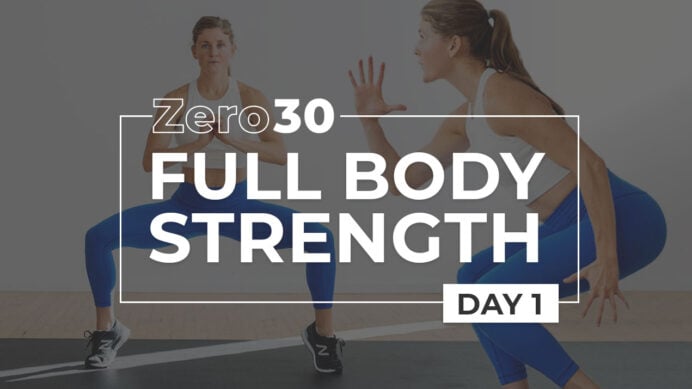


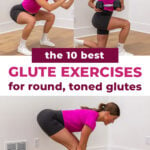
Leave a Comment